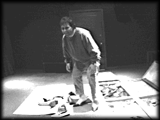|
 Feet Feet
|
|
|
|
A Foley artist is
sometimes called a 'Foley Walker' or 'Stepper'
because one of the most important elements we
provide is the sound of the footsteps. When the
original dialogue is replaced, due to noise or bad
performance, the sound of the actors walking also
needs to be redone.
Every footstep for
each character is covered; you must match the sync
of the steps, the surface (wood, marble, dirt etc.)
and the feeling (heavy, fast, angry, panicked etc.)
of each step!
|
Das
Boot!
|
|
Feet are very
difficult to perform. It takes a lot of practice to
get the exact feeling and timing while standing
stationary - you can' t walk across the room
because the microphone needs to be fixed and
besides, you don't have that much room!
Before
You Begin...
You will need many kinds of well worn shoes - a
trip to the Salvation Army store will yield many
treasures (cowboy boots, pumps, hard and soft
souled shoes) at a reasonable price. You may need
to 'gaff tape' any squeaky or loose ornamental bits
so they don't clutter the sound of the steps;
remember you are trying to record a clean, rich
sounding footstep and it doesn't matter what the
shoe looks like!
You will also need
several surfaces such as wood, concrete, metal and
gravel. A Foley Stage is specifically built to
accommodate these needs by having insulated 'pits'
which are several feet in width and filled with
these floor materials.
|
|
How
To Record A Foot Track...
You will
need a track for each main character in the film as
well as several for background or 'b.g. feet'. We
generally group tracks by Male or Female so that
the mixer can set the EQ (Equalization)
consistently (pumps are sharper than running
shoes!)
- The microphone
should be placed about three feet in front of
the Foley Artist when the scene is outdoors
(tight miked) and placed six to ten feet away
when the scene is indoors (loose miked). This
technique allows the mike to breath and provides
a roomy sound for indoor vs. a tight sound for
outdoors.
- We often use a
second mike on a boom, placed high in the room,
to capture the ambient room sound - this mike is
mixed into the single track while recording.
Using a second mike allows the Foley recordist
to mix fades and perspectives during the
recording session, but this is very tricky - the
problem is that you are limiting the mixer to
what you recorded with no chance to 'fix it in
the mix!'
- You will need
to 'ride the level' as characters enter or exit
a scene but be gentle and let the Foley Artist
work the fade as you do (this takes
teamwork!)
- If you have to
'punch into the track' (the artist missed a
footstep) you will need to get the rhythm of the
steps and punch in between footsteps! This
requires extreme precision, teamwork and
practice! Whenever possible, try to punch on a
scene cut or break in the action.
|
|
How
To Perform A Foot Track...
You will
need to select the appropriate shoes and surfaces
required in the film (boots, pumps, marble etc.)
Watch the picture carefully and remember that
sometimes what you hear on guide (the production
recording) is only a film set and its up to you to
create the best sounding footsteps:
- You will be
standing still (not actually walking!) and you
will be using one or two feet.
|
My
Favorite Pumps
|
- The action is
"heel / toe". While you are doing this you must
roll your foot from heel to toe, so as to create
the sound illusion of forward movement. The best
technique I have found is to roll from the outer
heel to the inner toe of your foot. Running
requires a quicker and shorter heel / toe action
as does climbing stairs! When the actor comes to
a stop, there is usually a definitive step or
weight shift which you must capture (this give a
feeling of closure to the movement.)
- To get "in
sync" with the actor, you must try to watch
their shoulders (not their feet!) - if you watch
their feet then you will never be in sync
because this technique is too reactionary. The
shoulders however, will give you the sense of
movement about to happen and when you sway and
move as the actor does, the feet just tend to
naturally sync up!
- When the sync
gets hard (some actors just do strange things
while walking!), count steps and get a pattern -
step, step, step, skip, stop. This you can
rehearse and then record.
(For an excersise in frustration, try doing Jack
Nicholsons feet in "As Good As It Gets" when he
walks down the sidewalk never touching the
cracks - Wow! Hats off to Andy Malcolm the
artist!!!)
- B.G. Feet are a
wash of foot tracks that fill the background
characters. Pick a person(s) on screen and
follow them - after a while of practicing, you
will be able to do several people at
once!
|
|
The
End Result...
When all
the steps are recorded (this can take several days
or weeks!) the foots track should sound distinct
and natural. Every character should be recognizable
(even when you don't see them on screen) and the
feeling of movement and action should be
captured.
There is no doubt
that doing feet is the hardest technique a Foley
Artist has to learn! Maybe that is why dancers make
such good Foley Artists!
|
 Feet
Feet

